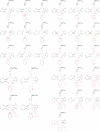Anticodon-dependent conservation of bacterial tRNA gene sequences
- PMID: 17379816
- PMCID: PMC1852809
- DOI: 10.1261/rna.345907
Anticodon-dependent conservation of bacterial tRNA gene sequences
Abstract
The residues in tRNA that account for its tertiary fold and for its specific aminoacylation are well understood. In contrast, relatively little is known about the residues in tRNA that dictate its ability to transit the different sites of the ribosome. Yet protein synthesis cannot occur unless tRNA properly engages with the ribosome. This study analyzes tRNA gene sequences from 145 fully sequenced bacterial genomes. Grouping the sequences according to the anticodon triplet reveals that many residues in tRNA, including some that are distal to the anticodon loop, are conserved in an anticodon-dependent manner. These residues evade detection when tRNA genes are grouped according to amino acid family. The conserved residues include those at positions 32, 38, and 37 of the anticodon loop, which are already known to influence tRNA translational performance. Therefore, it seems likely that the newly detected anticodon-associated residues also influence tRNA performance on the ribosome. Remarkably, tRNA genes that belong to the same amino acid family and therefore share identical residues at the second and third anticodon positions have diverged, during bacterial evolution, into highly conserved groups that are defined by the residue at the first (wobble) anticodon position. Current ideas about the properties of tRNA and the translation mechanism do not fully account for this phenomenon. The results of the present study provide a foundation for studying the adaptation of individual tRNAs to the translation machinery and for future studies of the translation mechanism.
Figures


Similar articles
-
Actions of the anticodon arm in translation on the phenotypes of RNA mutants.J Mol Biol. 1986 Nov 20;192(2):235-55. doi: 10.1016/0022-2836(86)90362-1. J Mol Biol. 1986. PMID: 2435916
-
Role of the three consecutive G:C base pairs conserved in the anticodon stem of initiator tRNAs in initiation of protein synthesis in Escherichia coli.RNA. 1996 May;2(5):473-82. RNA. 1996. PMID: 8665414 Free PMC article.
-
Anticodon sequence mutants of Escherichia coli initiator tRNA: effects of overproduction of aminoacyl-tRNA synthetases, methionyl-tRNA formyltransferase, and initiation factor 2 on activity in initiation.Biochemistry. 2003 May 6;42(17):4787-99. doi: 10.1021/bi034011r. Biochemistry. 2003. PMID: 12718519
-
tRNA's wobble decoding of the genome: 40 years of modification.J Mol Biol. 2007 Feb 9;366(1):1-13. doi: 10.1016/j.jmb.2006.11.046. Epub 2006 Nov 15. J Mol Biol. 2007. PMID: 17187822 Review.
-
[The tRNA anticodon is recognized by aminoacyl-tRNA-synthetase].Mol Biol (Mosk). 1989 Nov-Dec;23(6):1603-10. Mol Biol (Mosk). 1989. PMID: 2698995 Review. Russian.
Cited by
-
Promoter reuse in prokaryotes.Mob Genet Elements. 2012 Nov 1;2(6):279-281. doi: 10.4161/mge.23195. Mob Genet Elements. 2012. PMID: 23481313 Free PMC article.
-
Stable tRNA-based phylogenies using only 76 nucleotides.RNA. 2010 Aug;16(8):1469-77. doi: 10.1261/rna.726010. Epub 2010 Jun 17. RNA. 2010. PMID: 20558546 Free PMC article.
-
Unique cost dynamics elucidate the role of frameshifting errors in promoting translational robustness.Genome Biol Evol. 2010;2:636-45. doi: 10.1093/gbe/evq049. Epub 2010 Aug 5. Genome Biol Evol. 2010. PMID: 20688751 Free PMC article.
-
A sequence element that tunes Escherichia coli tRNA(Ala)(GGC) to ensure accurate decoding.Nat Struct Mol Biol. 2009 Apr;16(4):359-64. doi: 10.1038/nsmb.1581. Epub 2009 Mar 22. Nat Struct Mol Biol. 2009. PMID: 19305403 Free PMC article.
-
Unusual tertiary pairs in eukaryotic tRNAAla.RNA. 2020 Nov;26(11):1519-1529. doi: 10.1261/rna.076299.120. Epub 2020 Jul 31. RNA. 2020. PMID: 32737189 Free PMC article.
References
-
- Asahara, H., Himeno, H., Tamura, K., Hasegawa, T., Watanabe, K., Shimizu, M. Recognition nucleotides of Escherichia coli tRNALeu and its elements facilitating discrimination from tRNASer and tRNATyr. J. Mol. Biol. 1993;231:219–229. - PubMed
-
- Auffinger, P., Westhof, E. Singly and bifurcated hydrogen-bonded base pairs in tRNA anticodon hairpins and ribozymes. J. Mol. Biol. 1999;292:467–483. - PubMed
Publication types
MeSH terms
Substances
Grants and funding
LinkOut - more resources
Full Text Sources
